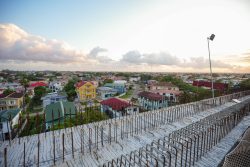(Trinidad Express) There are currently high concentrations of Saharan dust within Trinidad and Tobago’s atmosphere. The Trinidad and Tobago Meteorological Service is advising that sensitive groups, such as persons with asthma and respiratory illnesses, take necessary precautions.
On June 18, one of NASA’s satellites captured a “light brown plume of Saharan dust over the North Atlantic Ocean,” that extended from the African West Coast to the Lesser Antilles.
The dust plume travelled across the Atlantic and reached the Caribbean this weekend.
On Friday, the TTMS issued a notice on its Facebook page indicating that a significant amount of dust was projected in the area.
“Dust all around! Saharan dust is currently present in our atmosphere in moderate to high concentrations. Dust has reduced visibility over the Northern Range to as low as 6km (currently at 8km) as seen in the video taken at Piarco International Airport this morning…At this time models are suggesting that dust concentrations will decrease tomorrow (Saturday 20th June 2020), before again increasing significantly on Sunday 21st June 2020 and continuing for the next 2-3 days,” said the post.
Additionally, on Sunday morning, an updated post indicated that conditions are expected to persist until Friday 26, June. “The lowest visibility recorded so far was 700m in severe dust haze at 7:00am. These conditions are expected to persist at least until Friday 26th. Similar conditions are also being experienced in Tobago, with the lowest visibility recorded so far of 5000m.” According to a TTMS blog post on Friday, Saharan dust transportation to the Caribbean is due to a dry layer of air that is formed over the Sahara Desert. This layer of air extends from the surface and is carried by easterly winds into the atmosphere.
“There is a layer of air called the Saharan Air Layer (SAL) which is an extremely hot, dry and dust-laden layer of air that originates over the Sahara Desert of North Africa, where it extends from the surface upwards to several kilometres. It is fed by strong low to mid-level easterly winds over the desert which pulls sand and dust particles into the atmosphere. This is where the dust haze really emanates from.”
“This layer of dusty, very dry and warm air is pushed westward by the easterly winds and, on reaching the west African coast or eastern Atlantic Ocean, it rides over the cooler, more moist surface air of the Atlantic Ocean, forming what is called an atmospheric inversion layer or boundary: with warm, dry air aloft and cooler, moist air below,” said the post.
It added that once transported across the ocean, large deposits of dust are settled in areas of the Southern Caribbean. As the dust moves to the West, its dry warm dustiness is maintained. It is said to be notable during the June to August period.
“Once the SAL reaches the Atlantic, the easterly trade winds continue to carry this dust across the Atlantic at the lower and mid-levels, where eventually some of it, oftentimes large pools of it, lands over Trinidad and Tobago and the southern Caribbean. As the SAL moves westward, it maintains the characteristics of warm stable air at its base, and dryness and dustiness throughout its vertical profiles.”
“Records show a strong cycle that suggests that dust haze is most prevalent in Trinidad and Tobago during June to August and least during December to February. The SAL is therefore set to bring occasional dust haze over Trinidad and Tobago over the next three months,” it said.
In 2019 following a similar Saharan dust report by the TTMS, the Ministry of Health issued recommendations to the public. It advised and certain illnesses and symptoms could be worsened by the presence of the dust.
“The Ministry of Health advises that Saharan dust may contain various particles which can produce symptoms such as a dry cough, sore throat, itchy, watery eyes, sneezing and runny nose. High levels of Saharan dust may exacerbate illness in persons at high risk of respiratory complications including; Persons with pre-existing lung such as asthma disease, persons with pre-existing heart disease, the elderly and children.”
The Ministry asked that affected persons remain in-doors where possible and seek medical attention where necessary.






